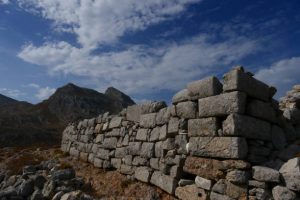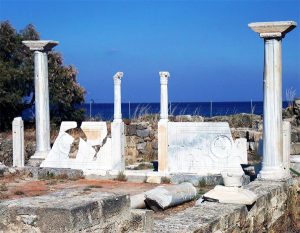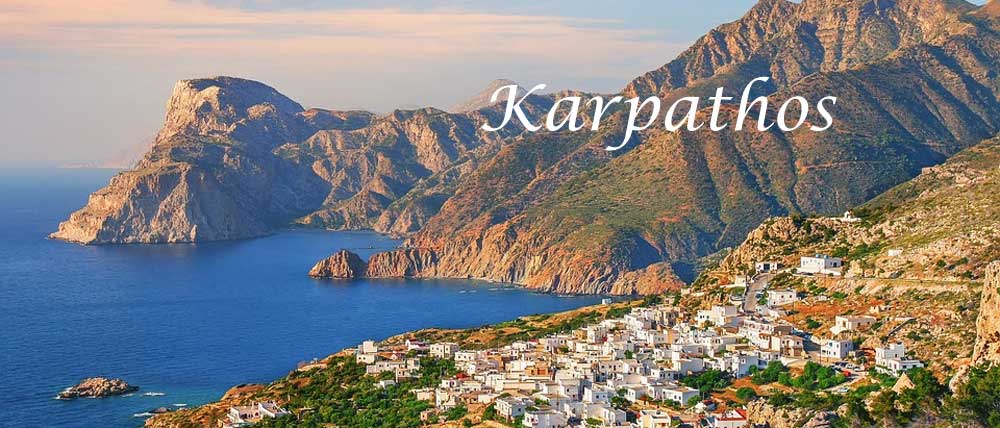Karpathos history through the ages
 Karpathos during its history, is mentioned by Homer, the earliest habitation of the island dates back to the 2nd millennium BC, as mentioned by Diodorus the Sicilian.
Karpathos during its history, is mentioned by Homer, the earliest habitation of the island dates back to the 2nd millennium BC, as mentioned by Diodorus the Sicilian.
Remains of Mycenaean tombs and settlements of the same period demonstrate life of the inhabitants of Karpathos.
Karpathos also is mentioned as taking part in the Trojan War. Later the Dorians occupy Karpathos, writers refer to it as the Tetrapolis, because it has four cities (Arkesia, Vrykous. Karpathos and the autonomous Saros). In the era of Diocletian between 245 – 313 AD. it belongs to the Province of the Islands (provincia insularum) and is a naval station of Rome in the Mediterranean.
About three centuries (700-1000 BC.) of decline and desolation follow, when pirates spread terror in the coastal settlements that are abandoned and the medieval mountain villages that are preserved to this day are created.
From 1206 to 1224 the island had come under the rule of Leos Gavalas, together with Kasos and Rhodes. In 1282 Karpathos was under the Genoese of Andrea Moresco, to pass in 1306 to the ruler of Crete Andrea Cornaro. He, being persecuted, gave it in turn, in 1313, to the Knights of St. John .
However, Andreas Kornaros returned in 1315 and his family ruled Karpathos until 1538, when the Ottomans of Barbarossa conquered it. The privileges granted, fiscal and administrative, helped substantially in the development of democratic institutions of self-government and the creation of a prosperous economic life.
An example of the administrative self-sufficiency of Karpathos during this period is that, until the last years of the Italian occupation, Olympus was governed by aldermen, elected every year. For a short period only (1823 – 30) it rests freely as a member of the Greek province, only to return through diplomatic force to the Ottomans. 1912 marks the beginning of the last period of slavery for Karpathos, that of the Italian occupation that ends in 1947 with the unification of the Dodecanese islands with Greece.
Mythology

Another version wants all the Titans to live on the island before the famous Battle of the Titans that Hesiod recounts, in which the Titans who were gathered on the top of Orthes were defeated by Zeus and the twelve gods who had Mount Olympus as their base. Thessaly.
Regarding the name of Karpathos there are various versions. One of them connects the name of the island with the karpaso plant that thrived in Karpathos. The same plant, however, gave its name to Karpasia, a city in Cyprus.
Homer mentions in the Iliad, that “Karpathos” took part in the Trojan War, sending ships. Another people who lived on the island were the Phoenicians, a seafaring people, who at that time crossed the Mediterranean with their ships and transported their products to various countries, thus developing trade and possibly also used Karpathos as their station.
A characteristic activity of the inhabitants of Karpathos during antiquity was the collection of red shells and by boiling them they created color which was used to dye fabrics. From the red color that was called purple, it also received the name Porphyria.
Something characteristic of the presence of the Phoenicians on the island of Karpathos is the name of the small port of Finiki, which is located on the west coast of the island and today is an attraction for visitors, mainly in the summer.
After the Mycenaeans and the Phoenicians, the Dorians came to the island around 1000 BC. The Dorians brought the greatest prosperity to the island. At that time, four fortified cities flourished and that is why Karpathos was called Tetrapolis during the Dorian era. These cities were Potidaeus or Poseidius, Arkesia, Vrychous and Nisyros, which is a rocky islet north of Karpathos.
Neolithic Period
The oldest traces of human presence on the island of Karpathos date back to the end of the Neolithic Period (4,000-3,000 BC). The first inhabitants seem to have come from Asia Minor and were related to the Pre-Hellenic peoples who lived in Crete and the other Greek islands (Kares, etc.).
The primitive Neolithic Civilization of Karpathos continues into the 3rd millennium BC, but around 2,000, Minoan settlers from Crete bring new life and economic prosperity to the island.
Neopalatial Period
During the Neopalatial Period of Crete (approx. 1700-1450 BC), which is also known as the “Era of Minoan Maritime Rule and Minoan Colonization”, Karpathos seems to have a purely Minoan character, it is populous and economically and culturally developed.
The historian Diodorus Sikeliotis mentions as the first inhabitants of Karpathos the Cretans, who were sent as colonists by King Minos, during his rule of the sea. They were followed, later, by Argites (apparently Mycenaeans) colonists, led by Ioclos, son of Demoleon.
Homeric years
Both Homer and archaeological data confirm the presence of the Achaeans (Greek Mycenaeans) on the island, although the Minoan character of its Civilization continued until the end of the Bronze Age. In the Trojan campaign, Karpathos takes part, under the orders of the Heraclides Pheidipus and Antiphos.
Archaic Period
There is no evidence of the fate of the island from the end of the Bronze Age until the Archaic Period. The Doric population seems to have dominated the island then, and the four cities that Strabo alludes to may have existed since the Archaic Period, if not earlier. Pigadia was in Antiquity, as it was until recently, the port of the city of Karpathos (today’s Aperio) and was called Poseidion. The other three cities were Arkesia, near present-day Arkasa, Vrykus (present-day Vrukunda, NW of Karpathos) and Nisyros, which may have been in present-day Palaces of Saria. Saria was, in ancient times, independent from Karpathos and was called Saros. After 478 BC Karpathos becomes a member of the First Athenian Alliance, as can be seen from the taxes that its cities paid to the Alliance treasury. In 404, with the end of the Peloponnesian War, it submitted to the Spartans, but after the naval battle of Kindos (394 BC) it returned to the Athenians and later, became a member of the Second Athenian Alliance.
Classical-Hellenistic Period
In the Classical and Hellenistic Periods, Karpathos appears to be economically alive and culturally prosperous. This is probably due, in large part, to the cultural and economic relations it develops with the cities of Rhodes, mainly with Lindos.
Much of the island, if not the whole, was part of the Rhodian or, more specifically, the Lindian state. The main city of the island was apparently Karpathos, which was probably located in today’s Aperi. This village seems to have continued to be the capital of Karpathos in later years.
Pirate raids
About three centuries (mid-7th to mid-10th AD) of decline and desolation follow. Pirates from North Africa and Asia spread terror and havoc in the abandoned coastal settlements. The place of the latter is taken by the medieval mountain villages that are preserved to this day.
Between 1204 and 1312, Karpathos became the object of competition between the Byzantines, Genoese, John Knights and Venetians, who claimed it, each on their own behalf.
The latter, with Andrea Cornaro, finally prevailed and remained lords of Karpathos and Kasos until 1538, when Hairedin Varvarossas occupies the islands on behalf of the Turks.
Ancient times
The island was first inhabited at the end of the Neolithic era, around 4,000 BC, when Asia Minor residents arrived and settled on the island, developing a culture until 2000 BC. About 1400 BC Mycenaean settlers arrive on the island and settle. However, due to sea raids, the island was deserted in 1200 BC, and was repopulated in 1000 BC by the Dorians. At this time, Karpathos knows great prosperity. The island was under Minoan influence and was later a member of the Athenian alliance until 400 BC, when it was conquered by the Rhodians. At the end of the 6th century, Karpathos is enslaved by the Persians, while in 478 it becomes a member of the Athenian alliance. During the Hellenistic period, it was a province of the Rhodian state. In ancient times, there were 4 fortified cities: Arkasia, Vrykous, Karpathos and Saros, on the islet of Saria.
Roman period
With its subjugation to the Romans, Karpathos acquires great strategic importance, since it is one of the three great navies of Rome in the Mediterranean. This position will also be held later, during the Byzantine Empire:
The sources typically state that the ships of the Carpathian navigable sea lead Nikiforos Phokas to Crete in 961 AD. Under Diocletian (284-305 AD) it was included in the “Province of the Islands” (Provincia Insularum) and under Heraklion (610-641) in the subject of Crete.
Middle Ages
In 42 BC Karpathos is occupied by the Romans, who seem to have granted privileges to the inhabitants. With its subjugation to the Romans, Karpathos is one of the three great nascents of Rome in the Mediterranean. Roman rule extends until 400 AD.
Then, the island passes to the Byzantine Empire, as the ships of the Carpathian Naustham lead Nikiforos Phokas to Crete in 961 AD. In the Byzantine years, pirates from North Africa, Arabs and Moors make raids on the island. This fact is the cause of the desolation of the coastal settlements and the creation of new ones, which are inhabited to this day, in remote mountainous areas. From 1204, when the island was occupied by the Crusaders, until 1537, it passed through the hands of many conquerors. It passed into the hands of the Genoese (Andrea and Ludovico Moresco), the Venetians (Cornaro family) and the Ottoman Turks. In the Middle Ages, the island was called Scarpanto in Venetian and Kerpe in Turkish.
Turkish rule
In 1538, the Ottomans of Barbarossa conquered Karpathos. The locals struggled to maintain the privileges that had been granted to them initially by the Sultan. Self-government on the island was exercised by the aldermen and the provosts, who undertook the collection of the tithe tax (mahto) and its payment to the local Ottoman “zambiti”. In 1821, Karpathos revolts and takes part in the fight for independence.
However, with the end of the Revolution, it remains, along with the other Dodecanese, a part of the Ottoman Empire, since for about ten years it fought for freedom and breathed the air of independence. In the period 1823 – 30, he recovered freely as a member of the Greek province, only to return through diplomatic force to the Ottomans. In 1830 with the London Protocol that defined the borders of the newly established Greek state, it again fell under the Ottoman Empire.
Italian occupation
In 1911, the Italo-Turkish war broke out over Libya, and the following year military operations were transferred to the Dodecanese. On May 18, 1912, the Turkish occupation was succeeded by the Italian one. The Turkish Customs Guard Station, which operated during the Ottoman Sultanate in the settlement, is replaced by the Guardia di Finanza Station, the royal Italian Customs.
The uprising of 1944
The uprising of October 5, 1944 was the result of a collective action of the village of Menetes, of the municipality of Menetarkassia, just one day after the completion of the withdrawal of the Germans. But let’s not forget that the island belonged to the Italians since 1912, who in turn had succeeded the Turks!
On the day of the Uprising, there were at least 250 armed Italian soldiers on the island, while the Italian political-military administration was still strangling the Carpathians like a noose. It is also worth pointing out that there was no communication with the surrounding world, nor was there any information about the military movements in the maritime area.
With the faith for mother Greece remaining unshakable, like the rock, the Menetians as a whole, were the first to take up arms and raise the blue and white flag. Then the lower villages also joined the struggle and thus a central Revolutionary Committee was formed. A few days later, the allies with the destroyers Cleveland and Terpsichori on October 17, 1944, occupied Karpathos
During World War II, in 1943, German troops arrived on the island and joined the Italians. The Germans left on October 4, 1944. Freedom came earlier than the rest of the Dodecanese, when on October 5, 1944, led by the inhabitants of Meneti, the revolution began and the Italians were expelled from the island.
Union with Greece
In March 1948, Karpathos, along with the rest of the Dodecanese, was incorporated into Greece.
